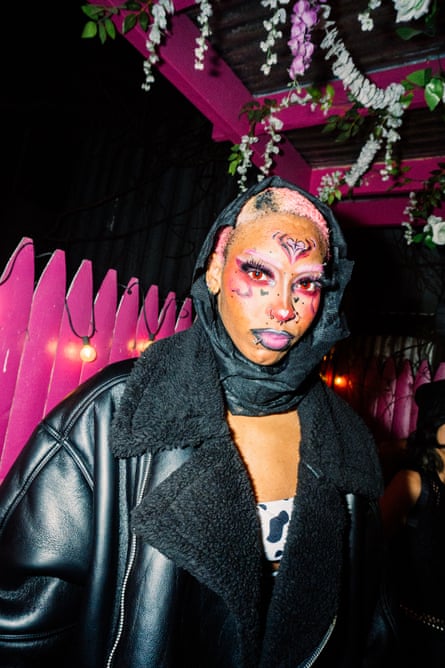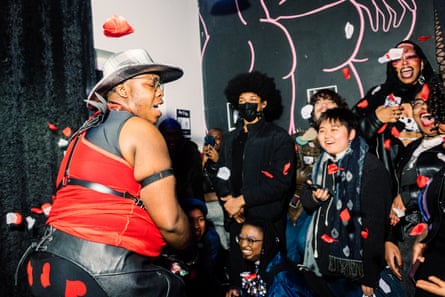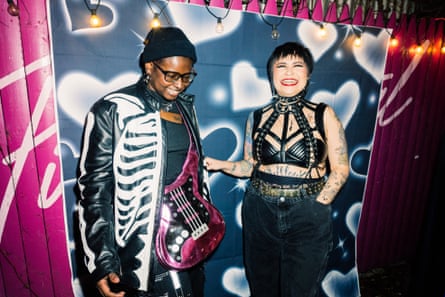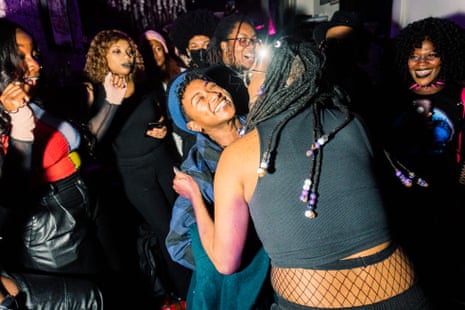Bipoc! At the Disco: the club night proving emo is for everyone | Music
Under a canopy of pink wisteria, Klondyke stands on a bar, lip-syncing My Chemical Romance’s Ghost of You in leather and lace. About 60 Black and brown faces packed into this tiny Brooklyn venue sing along as the drag performer opens a glass jar and guzzles the inky liquid inside. The elixir paints the inside of their mouth black as they act out the impassioned final chorus. This is Bipoc Emo Night, a burgeoning scene that celebrates the experience of queer, Black, and Indigenous emo fans.
Emo, an abbreviation of “emotional hardcore”, typically describes vulnerable anthems by bands such as Dashboard Confessional, Paramore, My Chemical Romance, and Fall Out Boy. The music spawned a culture rooted in a dark, fragile aesthetic that saw teens emerging from bedrooms in black skinny jeans and band T-shirts, brushing flat-ironed hair away from their kohled eyes. Communities formed around emo music on MySpace and at events like Warped Tour or among the clothing racks at Hot Topic.
But as with other rock subgenres, fans say the racial politics of the scene have long been fraught. Though the music is embraced by those who feel like outcasts, the emo scene hasn’t always felt welcoming to people of color.
“As a kid, I didn’t think going to emo shows was an option because I’d feel so afraid and alone,” says Andy Lawson, 29. He was eager to join the collective behind Bipoc Emo Night because even in 2023, he says, traditional emo spaces are “still super white dominated”.
“I’ve played shows and been to shows where people are wearing white pride T-shirts,” he says. “You have to watch in line waiting for the show for people you don’t want to go near, like, ‘Who looks like they’re going to try and hurt me?’”
Bipoc (Black, Indigenous and people of color) Emo Night is changing the narrative, says Hanz Odaga, a collective member who was born in Uganda and now lives in New Jersey. “We get out of the poison that was dealt in the 90s and mid-2000s, where all the movies we saw were like, ‘Black people like this music and white people like this music and that’s the way it is,’” Odaga says. “That’s the culture I grew up around and it was one of the most confusing experiences I had as a kid. Someone in my seventh grade class took my iPod and said, ‘You don’t look like you’d like this stuff.’ And I was like, ‘That’s not how this works.’”
In the last few years, emo and its aesthetic have seen a resurgence in popular culture thanks to Gen Z’s embrace of the genre on TikTok, emo and pop-punk-infused hits from artists like Olivia Rodrigo, and music festivals championing the bands of that era. That resurgence has coincided with millennial nostalgia and the explosion of popularity of “emo nights” across the US. The best known is Emo Nite, a franchise founded in 2014 whose founders played a DJ set at Coachella and secured a residency in Las Vegas.

The renewed interest has made it possible to create space specifically for “people who grew up in that scene but feel unseen”, explains Luna Becerra-Lewis, 27, who says they are an “emo kid for life”. Before the evening began, they helped set up, covering the bar in posters featuring the Venmo handles of that night’s drag performers so attendees could send tips.
As a 12-year-old enduring racist schoolyard taunts about their Mexican family, Luna Becerra-Lewis found solace in the emo music their older sister blasted while surfing MySpace. As an adult, they remember attending a local emo night event in 2021 in Las Vegas, where they saw another partygoer proudly sporting a “Make America Great Again” hat.
“It shocked me,” says Becerra-Lewis, who could be seen taking photos throughout the night in a spiked harness that complemented a tapestry of body tattoos. They knew emo had always been predominantly white, straight, and male, but seeing what they felt was a symbol of intolerance worn out in the open shifted something within them. “I realized this was not actually a welcoming space for everyone.”
Becerra-Lewis went home and searched for an event that prioritized the safety of people of color, but didn’t find one. So they hosted their first Bipoc Emo Night in December of 2021 and returned to the idea in November and December 2022 with events in New York City and Los Angeles.
“People were so interested in joining and collaborating that I was like, ‘What if we do this in other cities?’” Becerra-Lewis remembers. The project has since flourished into a loose collective of emo fans hosting Bipoc emo events in their hometowns across the US, featuring local drag artists and bands. All are welcome to attend, but “we want the messaging to be clear that [Bipoc people] are more the majority versus the minority” at these events and that they “always prioritize queer and trans folks”, says Becerra-Lewis.
Bipoc are often erased from the history of emo. “Punk and rock’n’roll started with Black folks and then [that recognition] all suddenly disappeared because of access and privilege,” says Lawson. “I think that emo was born of a lot of access and privilege and that’s why you saw so many white faces first. Getting a Les Paul [guitar] is expensive, renting a practice space, recording an album, having free time is expensive.
And emo’s “aesthetics of physical frailty matched with its [lyrical] vulnerability”, Lawson notes, so it valued “being super approachable and super cute and tied into white aesthetics for the most part”. White emo kids expressed themselves by straightening and dyeing their hair, but that wasn’t an option for Black teens unless they had the money to get their hair chemically straightened and grapple with changing an element of their identity. “And so for people of color, the emo scene is a little different to navigate,” says Lawson. “Take a person like me: I’m larger and a person of color so I’m more readily viewed as threatening. I don’t look as fun and cute and approachable.”


But the message of emo music, and its focus on introspection and emotional vulnerability, still resonated with him. “There’s a part of me that [emo music] speaks to because, being a person of color, you’re faced with a lot of existential dread really early.”
Born in Jamaica, Queens, Lawson moved to New York’s Hudson Valley as a kid and started listening to emo music in middle school, in a town that was white and Republican. The genre has helped him with his own identity. “At least for men or male-presenting folks, there [was] a lot of transgressing against typical masculine presentation.” As a teen, he saw himself in the music. “It ran counter to traditional masculinity. I didn’t know it at the time, but I’m a queer person so seeing different demonstrations of how masculinity could be displayed as vulnerable or sensitive was important.”
That emotional vulnerability also resonated with Odaga, who loudly cheered on the drag artists all night. “Joy is required,” he says of Bipoc Emo Night. Odaga, who calls himself a “chaotic elder bisexual” (he is 29), credits the scene with helping him heal a strained relationship with his father. “Emo music lets you pull [emotion] out for even the briefest moment, like: ‘I have something I’m letting out in this mosh pit and I have nothing but love for everyone that’s in the pit.’” The music “serves as catharsis and acceptance of situations as they are, especially when there’s nothing to do than to just be fed up and wish people were better,” he says.
Still, Lawson says, “even though emo ran counter to traditional masculinity, there was still a lot of misogyny and danger and harm that was still involved – queerbaiting or masking misogyny under the guise of vulnerability”.
But times have changed since the mid-2000s, he adds: “It’s not just white dudes with guitars any more.” In the last few years, a new wave of emo bands fronted by people of color have bubbled up to the forefront of the scene. Artists such as WILLOW and Magnolia Park are leading emo into a new decade of inclusion. Becerra-Lewis points to the Linda Lindas song Racist, Sexist Boy and Magnolia Park’s Don’t Be Racist as indicators of this shift.
“One of the most important lines to me in Don’t be Racist is ‘Black lives only matter for a moment, you only say it if it’s profit or promotion,’” says Odaga. “That’s something I felt all the time [as a teen] and for an artist to put out that signal flare in such a direct way lets you know that you can go to this band’s concert and everyone is on that same page.”

At Bipoc Emo Night, folks can let their guard down. A founding tenet of the collective is that no bigotry is tolerated. “It’s prescriptive in its intention that this is not a place you’re gonna fuck people around,” Lawson says. “This is a place you go to enjoy yourself. That language is so absent from most of the other hardcore and emo scenes. That’s why I was attracted to it. [I thought] I might be able to bring friends and not be like, ‘OK, I have to protect you.’
Back in the bar, it’s nearing 11.30 and the dance floor is heaving with energy. A drag performer unties his locs and begins head-banging and Odaga is right there with them, his earrings catching the light. They are in step, feeding off each other’s enthusiasm as someone yells: “Happy Black History Month!” The night continues until 2am, but the party is far from over. In March, the collective will bring Bipoc Emo Night to Washington DC and it will return to Brooklyn in April.
“To me, emo is radically accepting who you are, as opposed to who the world wants you to be … and knowing that it doesn’t change how Black you are,” Odaga smiles. “This culture can be for you.”
Under a canopy of pink wisteria, Klondyke stands on a bar, lip-syncing My Chemical Romance’s Ghost of You in leather and lace. About 60 Black and brown faces packed into this tiny Brooklyn venue sing along as the drag performer opens a glass jar and guzzles the inky liquid inside. The elixir paints the inside of their mouth black as they act out the impassioned final chorus. This is Bipoc Emo Night, a burgeoning scene that celebrates the experience of queer, Black, and Indigenous emo fans.
Emo, an abbreviation of “emotional hardcore”, typically describes vulnerable anthems by bands such as Dashboard Confessional, Paramore, My Chemical Romance, and Fall Out Boy. The music spawned a culture rooted in a dark, fragile aesthetic that saw teens emerging from bedrooms in black skinny jeans and band T-shirts, brushing flat-ironed hair away from their kohled eyes. Communities formed around emo music on MySpace and at events like Warped Tour or among the clothing racks at Hot Topic.
But as with other rock subgenres, fans say the racial politics of the scene have long been fraught. Though the music is embraced by those who feel like outcasts, the emo scene hasn’t always felt welcoming to people of color.

“As a kid, I didn’t think going to emo shows was an option because I’d feel so afraid and alone,” says Andy Lawson, 29. He was eager to join the collective behind Bipoc Emo Night because even in 2023, he says, traditional emo spaces are “still super white dominated”.
“I’ve played shows and been to shows where people are wearing white pride T-shirts,” he says. “You have to watch in line waiting for the show for people you don’t want to go near, like, ‘Who looks like they’re going to try and hurt me?’”
Bipoc (Black, Indigenous and people of color) Emo Night is changing the narrative, says Hanz Odaga, a collective member who was born in Uganda and now lives in New Jersey. “We get out of the poison that was dealt in the 90s and mid-2000s, where all the movies we saw were like, ‘Black people like this music and white people like this music and that’s the way it is,’” Odaga says. “That’s the culture I grew up around and it was one of the most confusing experiences I had as a kid. Someone in my seventh grade class took my iPod and said, ‘You don’t look like you’d like this stuff.’ And I was like, ‘That’s not how this works.’”
In the last few years, emo and its aesthetic have seen a resurgence in popular culture thanks to Gen Z’s embrace of the genre on TikTok, emo and pop-punk-infused hits from artists like Olivia Rodrigo, and music festivals championing the bands of that era. That resurgence has coincided with millennial nostalgia and the explosion of popularity of “emo nights” across the US. The best known is Emo Nite, a franchise founded in 2014 whose founders played a DJ set at Coachella and secured a residency in Las Vegas.

The renewed interest has made it possible to create space specifically for “people who grew up in that scene but feel unseen”, explains Luna Becerra-Lewis, 27, who says they are an “emo kid for life”. Before the evening began, they helped set up, covering the bar in posters featuring the Venmo handles of that night’s drag performers so attendees could send tips.
As a 12-year-old enduring racist schoolyard taunts about their Mexican family, Luna Becerra-Lewis found solace in the emo music their older sister blasted while surfing MySpace. As an adult, they remember attending a local emo night event in 2021 in Las Vegas, where they saw another partygoer proudly sporting a “Make America Great Again” hat.
“It shocked me,” says Becerra-Lewis, who could be seen taking photos throughout the night in a spiked harness that complemented a tapestry of body tattoos. They knew emo had always been predominantly white, straight, and male, but seeing what they felt was a symbol of intolerance worn out in the open shifted something within them. “I realized this was not actually a welcoming space for everyone.”
Becerra-Lewis went home and searched for an event that prioritized the safety of people of color, but didn’t find one. So they hosted their first Bipoc Emo Night in December of 2021 and returned to the idea in November and December 2022 with events in New York City and Los Angeles.
“People were so interested in joining and collaborating that I was like, ‘What if we do this in other cities?’” Becerra-Lewis remembers. The project has since flourished into a loose collective of emo fans hosting Bipoc emo events in their hometowns across the US, featuring local drag artists and bands. All are welcome to attend, but “we want the messaging to be clear that [Bipoc people] are more the majority versus the minority” at these events and that they “always prioritize queer and trans folks”, says Becerra-Lewis.
Bipoc are often erased from the history of emo. “Punk and rock’n’roll started with Black folks and then [that recognition] all suddenly disappeared because of access and privilege,” says Lawson. “I think that emo was born of a lot of access and privilege and that’s why you saw so many white faces first. Getting a Les Paul [guitar] is expensive, renting a practice space, recording an album, having free time is expensive.
And emo’s “aesthetics of physical frailty matched with its [lyrical] vulnerability”, Lawson notes, so it valued “being super approachable and super cute and tied into white aesthetics for the most part”. White emo kids expressed themselves by straightening and dyeing their hair, but that wasn’t an option for Black teens unless they had the money to get their hair chemically straightened and grapple with changing an element of their identity. “And so for people of color, the emo scene is a little different to navigate,” says Lawson. “Take a person like me: I’m larger and a person of color so I’m more readily viewed as threatening. I don’t look as fun and cute and approachable.”


But the message of emo music, and its focus on introspection and emotional vulnerability, still resonated with him. “There’s a part of me that [emo music] speaks to because, being a person of color, you’re faced with a lot of existential dread really early.”
Born in Jamaica, Queens, Lawson moved to New York’s Hudson Valley as a kid and started listening to emo music in middle school, in a town that was white and Republican. The genre has helped him with his own identity. “At least for men or male-presenting folks, there [was] a lot of transgressing against typical masculine presentation.” As a teen, he saw himself in the music. “It ran counter to traditional masculinity. I didn’t know it at the time, but I’m a queer person so seeing different demonstrations of how masculinity could be displayed as vulnerable or sensitive was important.”
That emotional vulnerability also resonated with Odaga, who loudly cheered on the drag artists all night. “Joy is required,” he says of Bipoc Emo Night. Odaga, who calls himself a “chaotic elder bisexual” (he is 29), credits the scene with helping him heal a strained relationship with his father. “Emo music lets you pull [emotion] out for even the briefest moment, like: ‘I have something I’m letting out in this mosh pit and I have nothing but love for everyone that’s in the pit.’” The music “serves as catharsis and acceptance of situations as they are, especially when there’s nothing to do than to just be fed up and wish people were better,” he says.
Still, Lawson says, “even though emo ran counter to traditional masculinity, there was still a lot of misogyny and danger and harm that was still involved – queerbaiting or masking misogyny under the guise of vulnerability”.
But times have changed since the mid-2000s, he adds: “It’s not just white dudes with guitars any more.” In the last few years, a new wave of emo bands fronted by people of color have bubbled up to the forefront of the scene. Artists such as WILLOW and Magnolia Park are leading emo into a new decade of inclusion. Becerra-Lewis points to the Linda Lindas song Racist, Sexist Boy and Magnolia Park’s Don’t Be Racist as indicators of this shift.
“One of the most important lines to me in Don’t be Racist is ‘Black lives only matter for a moment, you only say it if it’s profit or promotion,’” says Odaga. “That’s something I felt all the time [as a teen] and for an artist to put out that signal flare in such a direct way lets you know that you can go to this band’s concert and everyone is on that same page.”

At Bipoc Emo Night, folks can let their guard down. A founding tenet of the collective is that no bigotry is tolerated. “It’s prescriptive in its intention that this is not a place you’re gonna fuck people around,” Lawson says. “This is a place you go to enjoy yourself. That language is so absent from most of the other hardcore and emo scenes. That’s why I was attracted to it. [I thought] I might be able to bring friends and not be like, ‘OK, I have to protect you.’
Back in the bar, it’s nearing 11.30 and the dance floor is heaving with energy. A drag performer unties his locs and begins head-banging and Odaga is right there with them, his earrings catching the light. They are in step, feeding off each other’s enthusiasm as someone yells: “Happy Black History Month!” The night continues until 2am, but the party is far from over. In March, the collective will bring Bipoc Emo Night to Washington DC and it will return to Brooklyn in April.
“To me, emo is radically accepting who you are, as opposed to who the world wants you to be … and knowing that it doesn’t change how Black you are,” Odaga smiles. “This culture can be for you.”
